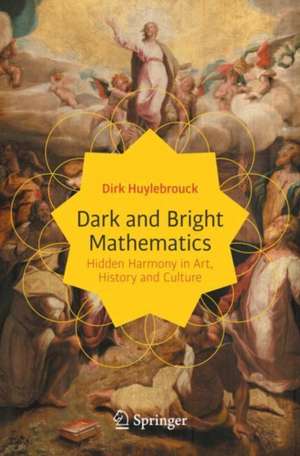Dark and Bright Mathematics: Hidden Harmony in Art, History and Culture: Copernicus Books
Autor Dirk Huylebroucken Limba Engleză Paperback – 20 oct 2023
Din seria Copernicus Books
- 5%
 Preț: 160.41 lei
Preț: 160.41 lei -
 Preț: 131.12 lei
Preț: 131.12 lei -
 Preț: 161.23 lei
Preț: 161.23 lei -
 Preț: 162.68 lei
Preț: 162.68 lei - 5%
 Preț: 123.81 lei
Preț: 123.81 lei -
 Preț: 136.09 lei
Preț: 136.09 lei - 5%
 Preț: 143.19 lei
Preț: 143.19 lei -
 Preț: 199.48 lei
Preț: 199.48 lei - 5%
 Preț: 125.14 lei
Preț: 125.14 lei -
 Preț: 123.27 lei
Preț: 123.27 lei - 5%
 Preț: 165.50 lei
Preț: 165.50 lei - 5%
 Preț: 202.46 lei
Preț: 202.46 lei -
 Preț: 125.51 lei
Preț: 125.51 lei -
 Preț: 110.05 lei
Preț: 110.05 lei -
 Preț: 103.91 lei
Preț: 103.91 lei - 5%
 Preț: 103.98 lei
Preț: 103.98 lei -
 Preț: 132.16 lei
Preț: 132.16 lei
Preț: 172.22 lei
Nou
Puncte Express: 258
Preț estimativ în valută:
32.96€ • 35.82$ • 27.71£
32.96€ • 35.82$ • 27.71£
Carte disponibilă
Livrare economică 31 martie-14 aprilie
Livrare express 15-21 martie pentru 28.68 lei
Preluare comenzi: 021 569.72.76
Specificații
ISBN-13: 9783031362545
ISBN-10: 3031362543
Pagini: 241
Ilustrații: XVII, 241 p. 186 illus., 160 illus. in color.
Dimensiuni: 155 x 235 x 16 mm
Greutate: 0.45 kg
Ediția:1st ed. 2023
Editura: Springer Nature Switzerland
Colecția Birkhäuser
Seria Copernicus Books
Locul publicării:Cham, Switzerland
ISBN-10: 3031362543
Pagini: 241
Ilustrații: XVII, 241 p. 186 illus., 160 illus. in color.
Dimensiuni: 155 x 235 x 16 mm
Greutate: 0.45 kg
Ediția:1st ed. 2023
Editura: Springer Nature Switzerland
Colecția Birkhäuser
Seria Copernicus Books
Locul publicării:Cham, Switzerland
Cuprins
Hell, Earth and Heaven in One Painting.- Hitler’s Math.- Guernica.- Architect-Alchemist.- War Hero, Math Genius, Martyr.- Murder and Higher Math.- Murdering Emperors.- When the Dead Talk in Code.
Notă biografică
Dirk Huylebrouck holds a PhD in mathematics from the University of Gent, Belgium. He worked at universities in the Congo for about eight years until a diplomatic incident between Belgium and Congo interrupted his stay. He went to the University of Aveiro, Portugal, and the European Division of Maryland University, until the majority of his American (military) students were sent to Iraq. He returned to Africa, to Burundi, but for only three years, because of the genocide in neighboring Rwanda. From 1996 until his retirement in 2022 he taught mathematics at the Faculty of Architecture of the KU Leuven (Belgium). In 2002 he won the American Mathematical association’s Lester Ford Award for best mathematical paper. From 1997 until 2017 he edited the column "The Mathematical Tourist" in the journal The Mathematical Intelligencer. From 2017 to 2020 he had a weekly column called "Professor Pi", in Belgium’s largest newspaper. His book Mathematics + Africa was his first in English(it appeared first in French and in Dutch). He wrote seven other books, in Dutch: The Codes of da Vinci, Bach, pi and Co, Belgium + mathematics, Mathart, Translation of Luca Pacioli’s Divine Proportion, The Columns of Professor Pi, Lugubrious Mathematics and Mathematical Coloring Book (translated in Chinese as well). He may soon flee abroad again having become (in) famous for his work in popularizing errors in, for example, the work of Leonardo da Vinci, the Belgian Atomium, a Brussels Airport runway, the interpretation of The Mystic Lamb, Francis Attard’s Fibonacci artwork, etc.
Textul de pe ultima copertă
Was it necessary for a 17th century painter to know principles of optics to hide a skull in one of his masterpieces? Is it possible the violent deaths of Roman emperors obey a statistical law? Are there connections between market trends and geometry? How did Islamic artists draw almost perfectly regular nine-sided polygons, when these cannot be traced with the use of compasses? Dirk Huylebrouk asks these and other exciting questions in this collection of essays, originally written for the science magazine EOS, a Dutch equivalent of Scientific American, distributed in Belgium and in The Netherlands. Every chapter can be read independently, as some subjects are repeated, and not strictly interconnected. Such is the case for instance of the golden section, an often-recurring topic in general mathematics. The reader will appreciate the original point of view expressed through each chapter, which makes this book stand out against the general information one can find by browsing the general media. The subtly provocative character of some parts is meant to stimulate the reader for further exploration. The book's title itself may already generate surprise. Sure, to many, mathematics seems to come from hell, but the darkness in the title in fact refers to the lugubrious stories about math and skulls, murders or World War II. There is also a more down-to-earth part about math and maps, money, Facebook, folding paper, shapes in ice and the most earthly yet unsolved math problems. ‘Bright mathematics’ alludes to Vedic, Islam, New Age, a meta-divine section, and is concluded by an interview with a top mathematician who also wrote about the existence of God.
Caracteristici
Collects translations of articles originally published in the Dutch magazine EOS Constitutes an original and thrilling piece for the general public which connects mathematics and culture Invites both academics and curious minds to reflect on the special entanglement of mathematics and humanity
